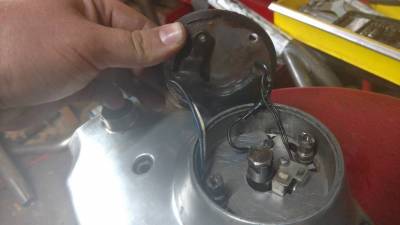Table of Contents
IH: Engine Control - Sub-01C
Prestolite Electronic Ignition System
(1979) Upgrade to the breaker point system in which the mechanical points are replaced by a breaker-less electronic ignition on the camshaft. Timer has a rotor with one small lobe and one large lobe and a sensor that sends signal to the control module on the back of the timer inner cover. Rotor is mounted on a mechanical flywheel centrifugal advance like a point cam would be in a breaker point system. The rotor's small lobe fires the front cylinder and the large lobe fires the rear cylinder. 1)1979 Ignition Module Assembly part number 32598-78 2).
- In November of 1978, the MoCo issued a few recommendations to dealers to handle issues with the leaned out condition related to this new ignition system. Motorcycles operate with leaner air/fuel mixtures and are more sensitive to carburetor mixture settings / ignition spark. 4)
- This involves checking the carburetor / manifold for leaks and insuring that the air cleaner backing plate has a tight connection. Corrective measures regarding the ignition on 1100, 1200 and 1340cc engines include: 5) See also Running Lean in the Sportsterpedia.
- Checking that the spark plugs, cables, boots and wiring connections are in good condition. If irregular running or spitting persists after making previously suggested checks, the spark plug gap should be increased to .060“. This has been found to improve engine combustion in some cases. 6)
- Make sure the ignition timer air gap is set as close as possible to the lower limit. Use a .004” feeler gauge to set clearance between the sensor and the trigger lobes per the FSM. Check both lobes to be sure they do not touch the sensor body. Review the FSM ignition section for other possible ignition system faults. 7)
- In May of 1980, the MoCo issued a Service Bulletin in response to having some owners of 1000cc and 1340cc engines, built since January 1, 1978, experience a knocking and / or pinging due to the unavailability of fuels with high enough octane ratings. Although retarding the spark advance will help to eliminate the knocking / pinging in an engine, a slight loss of power and fuel economy may be noticed by the owner. 8)
- However, reducing the spark advance on these engines a small amount, anywhere between 1°-10°, can help to eliminate this problem.
- Check the ignition timing to make sure it is set properly as described in the Service Manual.
- Set the timing if necessary:
- Turn the engine over until the timing mark is at the extreme front edge of the timing hole.
- Make a new timing mark with a piece of chalk at the extreme rear edge of the timing hole.
- Start the engine and set the idle speed at 2000 rpm. Retard the timing by shifting the timer plate so the new timing mark moves toward the front of the timing inspection hole. The timing advance should only be reduced in 2-1/2° increments and only enough to correct the problem. Timing should not be changed more than 10° (when the new timing mark is at the extreme front edge of the timing inspection hole).
Nosecone Ignition Seal
This is a steel shell radial shaft seal (HD# 11124) installed in the cam cover.
It surrounds and seals #2 cam when the cover is installed. Also used on 1986-2003 model Sportster cam covers.
Dims per XLForum member, Fizzle:
OD 1.570“ (39.878mm)
ID 1.050” (26.67mm)
W 0.248“ (6.2992mm)
Other brands include James (JGI-11124), Cometic (C9355), Athena (51-A210), Custom Chrome (54-043).
The rubber shell HD Genuine double lip version is part number (11124-DL).
Other brands include James (JGI-11124-DL).
NOTE: SKF makes a radial shaft seal with a part number of 11124 but that IS NOT AN HD PART NUMBER.
SKF 11124 IS TOO BIG TO FIT THE COVER and they don't show a compatible seal in their catalog for this application.
HD Seal (11124):


